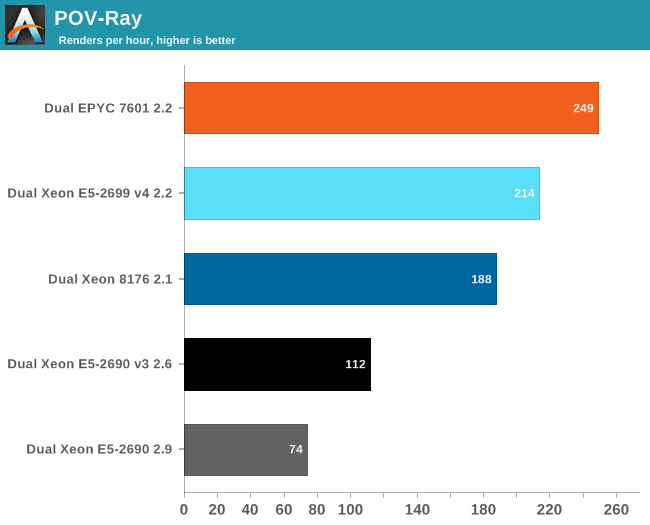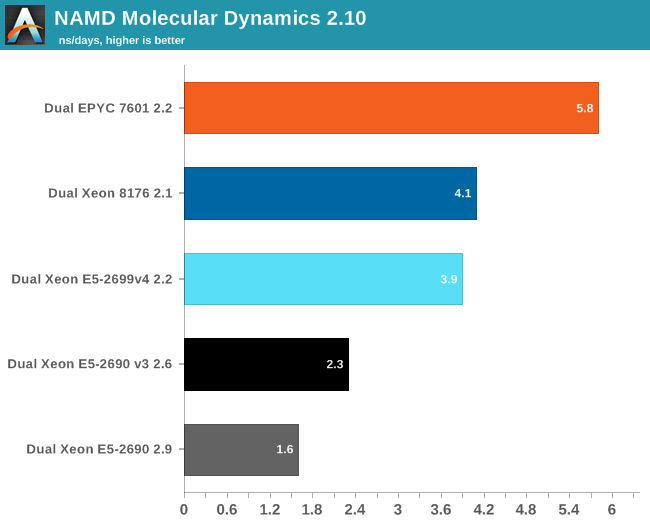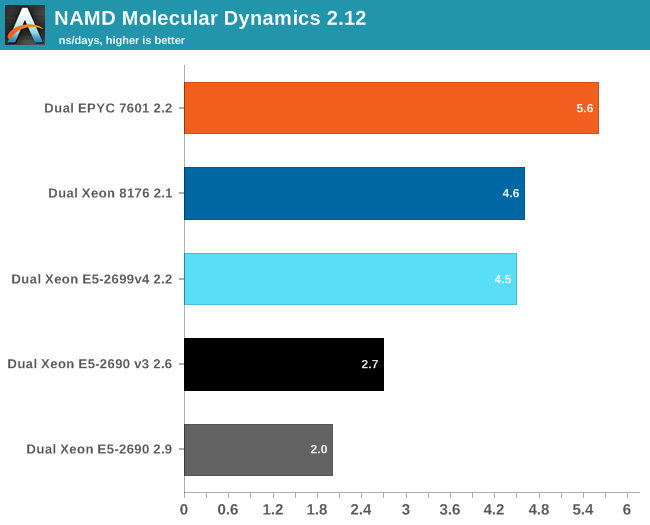Sizing Up Servers: Intel's Skylake-SP Xeon versus AMD's EPYC 7000 - The Server CPU Battle of the Decade?
by Johan De Gelas & Ian Cutress on July 11, 2017 12:15 PM EST- Posted in
- CPUs
- AMD
- Intel
- Xeon
- Enterprise
- Skylake
- Zen
- Naples
- Skylake-SP
- EPYC
Floating Point
Normally our HPC benchmarking is centered around OpenFoam, a CFD software we have used for a number of articles over the years. However, since we moved to Ubuntu 16.04, we could not get it to work anymore. So we decided to change our floating point intensive benchmark for now. For our latest article, we're testing with C-ray, POV-Ray, and NAMD.
The idea is to measure:
- A FP benchmark that is running out of the L1 (C-ray)
- A FP benchmark that is running out of the L2 (POV-Ray)
- And one that is using the memory subsytem quite often (NAMD)
Floating Point: C-ray
C-ray is an extremely simple ray-tracer which is not representative of any real world raytracing application. In fact, it is essentially a floating point benchmark that runs out of the L1-cache. Luckily it is not as synthetic and meaningless as Whetstone, as you can actually use the software to do simple raytracing.
We use the standard benchmarking resolution (3840x2160) and the "sphfract" file to measure performance. The binary was precompiled.

Wow. What just happened? It looks like a landslide victory for the raw power of the four FP pipes of Zen: the EPYC chip is no less than 50% faster than the competition. Of course, it is easy to feed FP units if everything resides in the L1. Next stop, POV-Ray.
Floating Point: POV-Ray 3.7

POV-Ray is known to run mostly out of the L2-cache, so the massive DRAM bandwidth of the EPYC CPU does not play a role here. Nevertheless, the EPYC CPU performance is pretty stunning: about 16% faster than Intel's Xeon 8176. But what if AVX and DRAM access come in to play? Let us check out NAMD.
Floating Point: NAMD
Developed by the Theoretical and Computational Biophysics Group at the University of Illinois Urbana-Champaign, NAMD is a set of parallel molecular dynamics codes for extreme parallelization on thousands of cores. NAMD is also part of SPEC CPU2006 FP. In contrast with previous FP benchmarks, the NAMD binary is compiled with Intel ICC and optimized for AVX.
First, we used the "NAMD_2.10_Linux-x86_64-multicore" binary. We used the most popular benchmark load, apoa1 (Apolipoprotein A1). The results are expressed in simulated nanoseconds per wall-clock day. We measure at 500 steps.

Again, the EPYC 7601 simply crushes the competition with 41% better performance than Intel's 28-core. Heavily vectorized code (like Linpack) might run much faster on Intel, but other FP code seems to run faster on AMD's newest FPU.
For our first shot with this benchmark, we used version 2.10 to be able to compare to our older data set. Version 2.12 seems to make better use of "Intel's compiler vectorization and auto-dispatch has improved performance for Intel processors supporting AVX instructions". So let's try again:

The older Xeons see a perforance boost of about 25%. The improvement on the new Xeons is a lot lower: about 13-15%. Remarkable is that the new binary is slower on the EPYC 7601: about 4%. That simply begs for more investigation: but the deadline was too close. Nevertheless, three different FP tests all point in the same direction: the Zen FP unit might not have the highest "peak FLOPs" in theory, there is lots of FP code out there that runs best on EPYC.










219 Comments
View All Comments
CajunArson - Tuesday, July 11, 2017 - link
Would a high-end server that was built in 2014 necessarily update? Maybe not.Should a high-end server with a brand new microarchitecture use the most recent version of the software if it has any expectation of seeing a real benefit? Absolutely.
If this was a GPU review and Anandtech used 2 year old drivers on a new GPU (assuming they even worked at all) we wouldn't even be having this conversation.
BrokenCrayons - Tuesday, July 11, 2017 - link
Home users playing video games are in a different environment than you find in a business datacenter. There's a lot less money to be lost when a driver update causes a performance regression or eliminates a feature. Conversely, needlessly updating software in the aforementioned datacenter can result in the loss of many millions if something goes wrong.wallysb01 - Tuesday, July 11, 2017 - link
Conversely, having stuff working, but unnecessarily slowly costs money as well. Its a balance, and if you're spending hundreds of thousands or even millions on a cluster/data center/what have you, you'd probably want to spend at least a little bit of time optimizing it, right?Icehawk - Tuesday, July 11, 2017 - link
Most of the businesses I have worked for, ranging from 10 people to 50k, use severely outdated software and the barest minimum of patching. Optimization? HA!For example I work for a manufacturer & retailer currently, our POS system was last patched in 2012 by the vendor and has been replaced by at least two versions newer. We have XP machines in each of our stores as that is the only OS that can run the software.
The above is very typical. The 50k company I worked for had software so old and deeply entrenched that modernizing it is virtually impossible. My current company is working on getting to a new product... that was new in 2012 and has also been replaced with a newer version. Whee!
Icehawk - Tuesday, July 11, 2017 - link
One other thing - maybe the big shops actually do test/size but none of the places I have worked at and have been involved in do any testing, benchmarking, etc. They just buy whatever their preferred vendor gives them that meets the budget and they *think* will work. My coworker is in charge (lol) of selecting servers for a new office... he has no clue what anything in this article is. He has never read a single review, overview, or test of a processor. I could keep going on like this :(0ldman79 - Wednesday, July 12, 2017 - link
Icehawk's comments are so accurate it is scary.I can't tell you how many businesses running custom *nix software running in a VM on a Windows server.
They're not all about speed. Reliability is the single most important factor, speed is somewhere down the line. The people that make those decisions and the people that drink coffee while they're waiting on the machines are very different.
Neither understand that it could all be done so much better and almost all of them are utterly terrified at the concept of speeding up the process if it means *any* changes are made.
JohanAnandtech - Friday, July 21, 2017 - link
We did test with NAMD 2.12 (Dec 2016).sutamatamasu - Tuesday, July 11, 2017 - link
Glad, AMD make back again to this segment, now we can only see what can Raja to do for server market with Radeon instinct.Kaotika - Tuesday, July 11, 2017 - link
So this confirms that the previous information regarding Skylake-X core configurations was wrong, and 12-core variant is in fact using HCC-core instead of LCC-core?Ian Cutress - Tuesday, July 11, 2017 - link
We corrected that in our Skylake-X review.